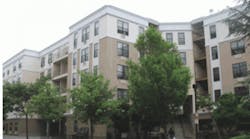A high-density low-rise rental-housing development in East Brooklyn, N.Y., Spring Creek Gardens recently underwent a top-to-bottom renovation, which included the replacement of all original hydronic heating equipment, a measure that has reduced the amount of natural gas consumed by residents by 30 percent.
"After years of service work by others attempting to apply bandaged solutions to multiple failing systems, we were given the approval to tackle the challenge with a comprehensive approach," Ike Beyer, president and co-owner of Long Island, N.Y.-based Integrated HVAC Systems & Services Inc., said.
The solution for "The Gardens" included an optimized heating and domestic-hot-water plant, with a focus on energy conservation and systems dependability.
The retrofit required several months of planning and six months of on-site work at a total cost of about $2.5 million. Each of the development's three buildings has two boiler rooms. In each of those boiler rooms, several LAARS Rheos+ boilers replaced 2-decades-old atmospheric systems that were, according to Beyer, doling out heat at 50- to 60-percent efficiency during their last few years of service.
According to Beyer, other boilers were specified for the project, but "with help from Don Rathe, Rathe Associates, we convinced the engineers and the building managers to go with our recommendation for 18 modulating-condensing Rheos+ boilers, ranging in size from 1.2 million to 2.4 million Btus."
Following extensive demolition and months of installation, all of the development's common and living areas are heated with high-temperature copper-fin-tube baseboard radiators.
The Rheos+ systems are controlled by building automation system through a variable firing-rate signal fed to each boiler as needed for heating and domestic hot water. The systems are responsive to indoor/outdoor-temperature-reset control for heating and maintain constant water-discharge temperature for domestic-hot-water production. In lieu of each boiler being operated independently, an integrated heating system that accepts remote signals for the control of multiple boilers to ensure optimal staging and rotation of the entire boiler plant was implemented.
"We stage and modulate operation of all boilers using Automated Logic DDC (direct-digital-control) controls," Beyer said. "Integrated also monitors and controls system operation remotely via our Web services back at our home office. We custom-engineered the control system to integrate with LAARS’ onboard controls. LAARS configures these boilers to integrate seamlessly with building-system management.
"Integrated wrote the programs for this job not only to sequence all system operations, but also to send alarms to the customer—and to us—if there would be a need," Beyer continued. "We also have the capability to track fuel-usage data."
According to Beyer, the heating loop has its own secondary distribution pumps. Variable-frequency drives were installed to modulate demand-based pump output.
To dispose of potentially harmful acidic condensate, each boiler is fitted with a neutralizer kit from LAARS. Condensate is run through a marble-chip bath that neutralizes it from an acidic-pH range of 5.2 to 5.6 and disposed of down a typical sanitary drain.
The boilers have dedicated integral recirculating pumps.
"Some other manufacturers require you to provide those pumps separately, and given our schedule, that was definitely a minus," Beyer said.
A low-loss header separates the production and distribution sides of the system.
"The boilers' ability to maintain discharge temperatures ranging from domestic hot water to peak heating requirements provided the best demand-to-output capacity match at the most efficient energy level," Beyer said. "Maintaining the highest efficiency level provides an additional way of controlling emission levels because the more efficiently we operate, the less gas we burn and the fewer oxides we emit, reducing our carbon footprint."
Domestic water for residents is sourced through large indirect water heaters. The equipment increases the volume of stored hot water, which helps to eliminate short-cycling during periods of low demand. Meanwhile, an Exhausto chimney venting system maintains proper draft across the full firing rate of the heating system.
The boilers also provide:
- Modulation of firing rate from 25 percent to full fire to match required heat loads and maximize efficiency.
- A built-in mixing system for low-temperature return-water protection and maintenance of proper flow rates through the heat exchangers.
- A visible front control panel for easy diagnostics and access to internal electronics.
- Flexible vent and piping options.
- Hot-water-supply-temperature optimization.
"We took the system improvements as far as we could so far," Beyer said. "We optimized heat-plant operations for both space heat and domestic water, but hope to add indoor feedback sensors to further improve comfort and energy conservation, especially for the apartments."









